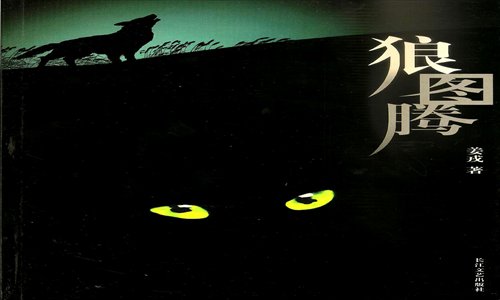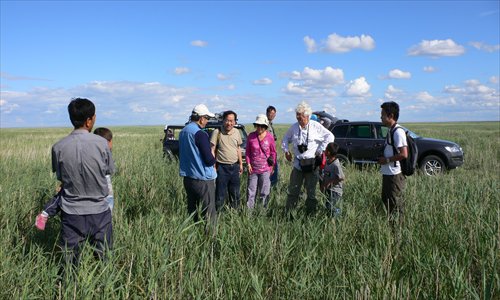A book in film's clothing


Renowned French director Jean Jacques Annaud is preparing the film adaptation of Wolf Totem. Early this month, the production team held an opening ceremony to commence the shooting of the film.
The novel, written under the pen name Jiang Rong was published in 2004. Since then, the novel has been translated into more than 30 languages and published in 110 countries and regions.
Wolf Totem chronicles a young man from Beijing who volunteers to live in a region on the border of China and Mongolia in the late 1960s during the Cultural Revolution (1966-76). With the mixing of cultures and languages, the adaptation process has been both challenging and rewarding.
Howling trend
Since its publication, the book has attracted a great deal of controversy. Many doubt the authenticity of the story, as it claimed to be semi-autobiographical.
Historians have not verified Jiang's description in the book, where the wolf totem represents Mongolian culture.
Like Jiang, the protagonist in the book Chen Zhen is zhiqing, a term that refers to educated youth sent to rural areas during the Cultural Revolution.
During his adventure, Chen learns about the struggle between humans and nature, as well as the conflict between prairie and modern Han culture. He also experiences the complicated relationship between wolves and humans.
Last week, two new arrivals featured themes on wolves: The "wolf encyclopedia," or The Dog of Heaven: Truth and Myths of Blue Mongolia's Blue Wolf, and non-fiction book Chongfan Langqun (back to wolves).
The two books have raised discussions about the reliability of the wolf totem in Mongolian culture documented in Jiang's book.
French interpretation
Beijing Forbidden City Film Corporation bought the copyrights for the book in 2004 after the book was published. Struggling to find a director to take on the project, the producing company waited until the English and French versions were published in 2008 to renew the copyrights in 2009, finally settling on Annaud as the director.
Annaud's connection with the story came from his personal experience in Africa, when he was stationed there for military service in his 20s.
His first film Black and White in Color was shot in Africa. As a young man who left a city for an unfamiliar rural area, Annaud shares similarities with Chen.
Annaud expressed publicly in 2009 that his time in Africa, coupled with his filming experience with bears, tigers and other big animals, made him suited for the job. For him, themes revolving around nature and the environment are universal.
"Since we became friends with Annaud, we call him French Zhiqing," said Xu Jianhai, one of the executive producers of the film.
Xu told Global Times that though cultures vary, feelings about cultural conflicts are the same.
"Han people might not understand Mongolian culture. Annaud's interpretation may not be the same as Jiang but they can reach an agreement anyway," said Xu.
According to Xu, Chinese scriptwriter and director Lu Wei has been writing the Chinese script since 2009. Lu has worked with many renowned figures of China's so-called fifth generation of directors.
Previous scripts include Farewell My Concubine, To Live and Tuya's Marriage.
Since taking on Wolf Totem, Lu has consistently been in discussion with Jiang and Annaud. The process is dually complicated, as the script has to be translated into French for Annaud's feedback, then Chinese for Lu to polish.
The final script is still in the works, and language for spoken dialogue has not been agreed upon.
Casting humans, animals
Producers are currently holding auditions for the main roles. One main requirement for actors is to have strong language skills.
"Translations cannot be perfect. Even with interpreters, it is important for actors to have the ability and intelligence to understand the director's explanation," said Xu.
The production team is now filming experimental scenes with animals, as the most difficult part of this film project is to prepare and film a large number of animals.
To purchase baby wolves, train, feed and protect them involves many complexities. The producing company invited four Canadian wolf trainers to Beijing.
"The wolves can only understand English now," added Xu.
"Other animals are also involved in the casting process. Mongolian gazelles are hard to come by in Inner Mongolia now. We have to go to Mongolia and find them," added Xu.
Annaud is famous for shooting real animals in films such as The Bear and Two Brothers.
He plans to use post-production technology to render scenes that would otherwise be impossible to film. Aside, the production team hopes to use as much real footage as possible.
The wolves, the key "actors," have been in training for more than two years to prepare for their roles.
"The most exciting parts from the novel, like the scene of the wolves killing the Mongolian gazelles and the fight between human and wolves, these will all be included in the adaptation," said Xu.
Xu told the Global Times that they plan to shoot the film in 3D, but since two cameras will film at the same time, it creates difficulty when shooting animals.